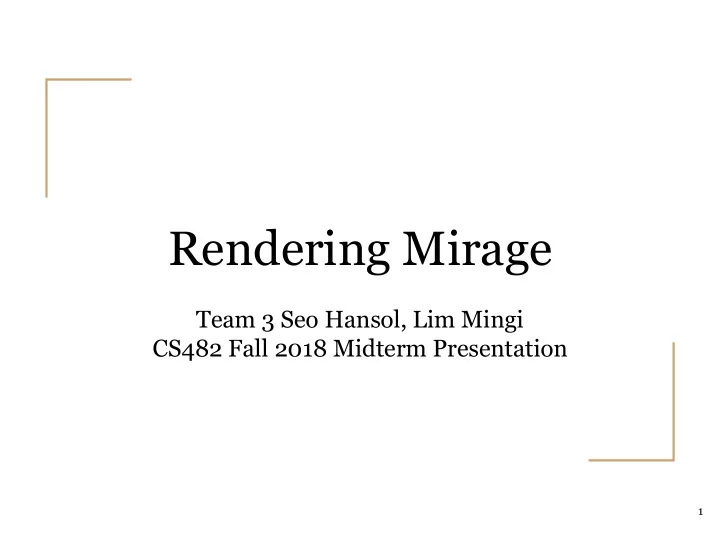

Rendering Mirage Team 3 Seo Hansol, Lim Mingi CS482 Fall 2018 Midterm Presentation 1
Contents ● Introduction ● Background ● Previous Works ● Our Ideas 2
Introduction 3
Mirage inferior mirage superior mirage By Conjecture Corporation By Shawn Stockman-Malone 4
Mirage inferior mirage superior mirage Both by Ludovica Lorenzelli 5
Our Goal We want to render realistic, artistic mirages. By Shawn Stockman-Malone From [ABW14] 6
Background 7
Mirage Image: The Physics By Ludovica Lorenzelli 8
Mirage Image: The Physics High T → Low ρ → High v → Low n Low T → High ρ → Low v → High n By Ludovica Lorenzelli 9
Mirage Image: The Physics High T → Low ρ → High v → Low n Low T → High ρ → Low v → High n By Ludovica Lorenzelli 10
Mirage Image: The Physics High T → Low ρ → High v → Low n Low T → High ρ → Low v → High n By Ludovica Lorenzelli 11
Mirage Image: The Physics superior mirage inferior mirage 12
Previous Works 13
Previous Works ● Modeling refractive index of atmosphere ● Rendering through refractive index model ● Artistic editing by user 14
Refractive Index Modeling Of Atmosphere ● Simulation of atmospheric phenomena [GSM*06] ● Atmospheric Profile Manager (APM) ● Simplified model of temperature, refractive index similar to real atmosphere 15
Refractive Index Modeling Of Atmosphere De-standardization Standardized Inversion Layer Background Hot Spot From [GSM*06] From [GSM*06] From slides of [Choi 17] 16
Rendering Through Refractive Index Model ● Refractive radiative transfer equation [ABW14] ● Applies Hamiltonian optics to the rendering equation Image from [ABW14] 17
Artistic Editing ● Interactive reflection editing [ROT*09] ● User controllable reflection, defying physics ● Intuitive UI Image from [ROT*09] 18
Artistic Editing ● State of the art in artistic editing of appearance, lighting and material [SPN*14] ● User controlled lighting, BRDF, etc. ● Goal based interaction; user defines goal, system solves. Images from [ABW14] 19
Previous Approaches To Mirage Rendering ● Visual simulation of heat shimmering and mirage [ZHF*07] ● Build refractive index from object heat map, renders with ray marching Image from [ZHF*07] 20
Artistic Editing For Mirage Image 21
Artistic Editing For Mirage Image [Choi 2017] [Demo video] 22
Overview ● Source-to-Destination Point Pair ○ The user specifies constraints, defined as a set of original position (source) + mirage image position (destination) ● Perform physically correct light path calculation ● Use parametric optimization to calculate ○ With an appropriate refractive index distribution model for the optimization This slide is copied 23 from slides of [Choi 17]
Source-to-Destination Point Pair This slide is copied 24 from slides of [Choi 17]
Source-to-Destination Point Pair This slide is copied 25 from slides of [Choi 17]
Source-to-Destination Point Pair This slide is copied 26 from slides of [Choi 17]
Refractive Index Distribution Model Adapt APM [GSM*06] as a spatial encoding This slide is copied 27 from slides of [Choi 17]
Refractive Index Distribution Model Plot of APM vs. New Formulation This slide is copied 28 from slides of [Choi 17]
Refractive Index Distribution Model New formulation suggested for the refractive index distribution: Logistic Approximation 29
Spatial Encoding and Optimization ● Let the m-dimensional spatial encoding of n(x) be L ● And let the parameter vector for L be 30
Spatial Encoding and Optimization ● Distance Function ○ Define distance per point pair , as the shortest distance between the Source Point and the light path This slide is copied 31 from slides of [Choi 17]
Spatial Encoding and Optimization ● Distance Function ○ For i-th pair, spatial encoding L , and parameter vector k This slide is copied 32 from slides of [Choi 17]
Spatial Encoding and Optimization ● Cost Function ○ For i-th pair, spatial encoding L , and parameter vector k ○ solve by Regression This slide is copied 33 from slides of [Choi 17]
Rendering method ● Ray-marching algorithm Image from https://computergraphics.stackexchange.com/questions/161/what-is-ray-marching-is-sphere-tracing-the- 34 same-thing
Rendering method ● Ray-marching algorithm https://github.com/yoonlab/refracti ve-index- [ABW14] 35 editor/blob/master/shaders/compo site.frag
Limitations ● This system is focused on creating static scenes ○ This formulation does not consider the spatial location of the hot spot and the inversion layer ○ When you move the camera , you ’ ll see a different scene than you intended ● No illumination model ● Poor, unintuitive UI ⇒ Unrealistic mirage scenes 36
Our Ideas 37
Areal Hot Spot ● Hot spot is no longer depends on only height ● Hot spot has xy-position and size, defined by user ● Optimize additional parameters using the existing optimizer ● By changing the formula to take into account the area of the hot spot , we can see a more realistic scene even if we move the camera 38
Areal Hot Spot Hot Spot 39
Atmospheric Noise ● Temperature variance is not smooth in real ● Air turbulences result in noises in real image ● We can add some noises to the scene for more realistic image ○ Temperature noise to model ○ Geometric noise to ray 40
Local Illumination Model: Phong Illumination ● Phong Illumination ● Complex global illumination is overkill in large outdoor scene with bright sunlight ● Phong illumination is simple and plausible enough 41
Texture Filtering ● Mip-mapping ● Anisotropic filtering ● Ray differential 42
Better UI ● Point positioning ● Camera positioning ● More interactive point addition and rendering; user should be able to see result of point addition more frequently ● Point importance 43
Better UI: Point Importance ● User defines optimization rate (intensity) for each point ● Optimizer has larger margins for less important points 0.2 0.6 0.2 44
Members & Roles ● Seo Hansol : Setting up the environment, Presentation, Coding ● Lim Mingi : Presentation, Coding 45
Q & A 46
Recommend
More recommend